| Revision as of 00:31, 13 April 2012 editImageRemovalBot (talk | contribs)Bots352,796 edits Removing links to deleted file File:Lobo Texas.jpeg← Previous edit | Revision as of 08:30, 15 April 2012 edit undoVerman1 (talk | contribs)Extended confirmed users947 edits →Post-Soviet statesNext edit → | ||
| Line 266: | Line 266: | ||
| ], Azerbaijan]] | ], Azerbaijan]] | ||
| Apart from ], many abandoned towns and settlements are located in northern Russia (], ], ], ]). There are several towns that were established near Soviet concentration camps to supply necessary services. Since most of the ] installations were abandoned in the 1950s, the towns were abandoned, as well. One such town is located near the former Gulag camp called ] (also called Lower Butugychag). There are several Soviet settlements that were abandoned on the Norwegian island of ] in the town of ]. Other towns were deserted due to deindustrialisation and the economic crises of the early 1990 attributed to ]. |
Apart from ], many abandoned towns and settlements are located in northern Russia (], ], ], ]). There are several towns that were established near Soviet concentration camps to supply necessary services. Since most of the ] installations were abandoned in the 1950s, the towns were abandoned, as well. One such town is located near the former Gulag camp called ] (also called Lower Butugychag). There are several Soviet settlements that were abandoned on the Norwegian island of ] in the town of ]. Other towns were deserted due to deindustrialisation and the economic crises of the early 1990 attributed to ]. | ||
| ], Azerbaijan is an example of this. In July 1993, after heavy fighting, Agdam was ] by the forces of the ] during its ]. As the town fell, its entire population were forced to flee eastwards. Many were killed by Armenian soldiers. In the immediate aftermath of the fighting, the Armenian forces decided to destroy much of Agdam to prevent its recapture by Azerbaijan.<ref>Nicolas Holding, "Armenia with Nagorno Karabagh - Bradt Travel Guide", 2003, p200.</ref> More damage occurred in the following decades when the deserted town was looted for building materials. Agdam is currently a ruinous, uninhabited ].<ref> {{ru icon}}</ref> The town's large ] also survives in bad condition.<ref></ref> | |||
| Even more semi-deserted towns are situated in ]'s Abkhazia, notably ] and ].<ref>{{cite web |url=http://www.undp.org.ge/news/agricabh.pdf |title=The agricultural sector in Ochamchira, Tkvarcheli and Gali, Abkhazia, Georgia |format=PDF |date= |accessdate=2009-08-25}} {{Dead link|date=September 2010|bot=H3llBot}}</ref> | |||
| In European Russia, many villages have been depopulated since the 1940s.<ref>{{cite web|url=http://findarticles.com/p/articles/mi_hb6465/is_200305/ai_n25686585 |title=Russia: more evidence found of rural depopulation trend.(Brief Article) | IPR Strategic Business Information Database | Find Articles at BNET |publisher=Findarticles.com |date=2009-06-02 |accessdate=2009-08-25}} {{Dead link|date=September 2010|bot=H3llBot}}</ref> | In European Russia, many villages have been depopulated since the 1940s.<ref>{{cite web|url=http://findarticles.com/p/articles/mi_hb6465/is_200305/ai_n25686585 |title=Russia: more evidence found of rural depopulation trend.(Brief Article) | IPR Strategic Business Information Database | Find Articles at BNET |publisher=Findarticles.com |date=2009-06-02 |accessdate=2009-08-25}} {{Dead link|date=September 2010|bot=H3llBot}}</ref> | ||
Revision as of 08:30, 15 April 2012
For settlements that never existed, see Phantom settlement. For other uses, see Ghost town (disambiguation).| This article needs additional citations for verification. Please help improve this article by adding citations to reliable sources. Unsourced material may be challenged and removed. Find sources: "Ghost town" – news · newspapers · books · scholar · JSTOR (February 2009) (Learn how and when to remove this message) |

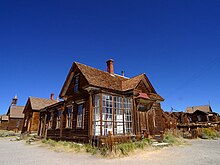
A ghost town is an abandoned village, town or city. A town often becomes a ghost town because the economic activity that supported it has failed, or due to natural or human-caused disasters such as floods, government actions, uncontrolled lawlessness, war, or nuclear disasters. The term is sometimes used to refer to cities, towns, and neighborhoods which are still populated, but significantly less so than in years past.
Some ghost towns are tourist attractions: Barkerville, British Columbia; Bannack, Montana; Calico, California; Elizabeth Bay, Namibia; Pripyat, Ukraine; Kolmanskop, Namibia; and Oatman, Arizona among them. This is especially true of those that preserve period-specific architecture. Visiting, writing about, and photographing ghost towns is a minor industry.
Proposed characteristics of a ghost town


T. Lindsay Baker holds the W.K. Gordon Chair in Industrial History at Tarleton State University in Stephenville, Texas and has researched many ghost towns throughout Texas, recording his findings in the books Ghost Towns of Texas and More Ghost Towns of Texas. Baker has proposed a short set of guidelines that he uses to distinguish a genuine ghost town from a dispersed rural community or a vanished or phantom settlement:
The town's reason for being must no longer exist. Although abandoned sites clearly meet this requirement, this does not exclude certain semi-abandoned sites from being classified as ghost towns, provided they maintain only a skeleton population.
There must be tangible remains of the town for visitors to see. These can range from a dilapidated main street populated with abandoned mercantile/government buildings to only a town cemetery (Baker also stipulated that townsites included in his own books must have public access and be evenly distributed throughout Texas).
Reasons for abandonment
Factors leading to abandonment of towns include depleted natural resources, economic activity shifting elsewhere, railroads and roads bypassing or no longer accessing the town, human intervention, disasters, massacres, wars, and the shifting of politics or fall of empires.
Depleted natural resources
Ghost towns may result when the single activity or resource that created a boomtown (e.g., nearby mine, mill or resort) is depleted or the resource economy undergoes a “bust” (e.g., catastrophic resource price collapse). Boomtowns can often decrease in size as fast as they initially grew. Sometimes, all or nearly the entire population can desert the town, resulting in a ghost town.
Economic activity shifting elsewhere
The dismantling of a boomtown can often occur on a planned basis. Mining companies nowadays will create a temporary community to service a mine-site, building all the accommodation shops and services, and then remove it as the resource is worked out.
Human intervention
Railroads and roads bypassing or no longer accessing a town can create a ghost town. This was the case in many of the ghost towns along Ontario's historic Opeongo Line, and along U.S. Route 66 after motorists bypassed the latter on the faster moving highways I-44 and I-40.
River re-routing is another factor, one example being the towns along the Aral Sea.
Ghost towns may be created when land is expropriated by a government and residents are required to relocate. An excellent example is the village of Tyneham in Dorset, England, acquired during World War II to build an artillery range. Another example is when NASA acquired land to build a rocket propulsion testing center. Construction of the John C. Stennis Space Center in Mississippi, U.S., required acquisition of a large buffer zone (approximately 34 square miles) because of the loud noise and potential dangers associated with testing huge rockets. Communities were abandoned and roads became overgrown with forest flora.
Sometimes, the town might cease to officially exist, but the physical infrastructure remains. One example of this is the former town of Weston, Illinois, which voted itself out of existence and turned the land over for construction of the Fermi National Accelerator Laboratory. Many houses and even a few barns remain, used for housing visiting scientists and storing maintenance equipment, while roads that used to cross through the site have been blocked off at the edges of the property, with gatehouses or simply barricades to prevent unsupervised access.
Construction of dams has produced ghost towns left underwater. Examples include the settlement of Loyston, Tennessee, U.S., inundated by the creation of Norris Dam. The town was reorganised and reconstructed on nearby higher ground. Other examples are The Lost Villages of Ontario, the hamlets of Nether Hambleton and Middle Hambleton in Rutland, England, which were flooded to create Rutland Water, Europe's largest man-made reservoir, and the villages of Ashopton and Derwent, England, flooded during the construction of the Ladybower Reservoir. Mologa in Russia was flooded by the creation of Rybinsk reservoir. Many ancient villages had to be abandoned during construction of the Three Gorges Dam in China, leading to displacement of many rural people. In the Costa Rican province of Guanacaste, the town of Arenal was rebuilt to make room for the man-made Lake Arenal. The old town now lies submerged below the lake.
Epidemics
Significant fatality rates from epidemics have produced ghost towns. For example, some places in eastern Arkansas were abandoned after over 7,000 Arkansans died during the Spanish Flu epidemic of 1918 and 1919.
Disasters, actual and anticipated
Natural and man-made disasters can create ghost towns. For example, after being flooded more than 30 times since their town was founded in 1845, residents of Pattonsburg, Missouri, had enough after two floods in 1993. With government help, the whole town was rebuilt 3 miles (4.8 km) away. Centralia, Pennsylvania was abandoned in 1984 after a uncontainable mine fire began in 1962.
Ghost towns may also occasionally come into being due to an anticipated natural disaster – for example, the Canadian town of Lemieux, Ontario was abandoned in 1991 after soil testing revealed that the community was built on an unstable bed of Leda clay. Two years after the last building in Lemieux was demolished, a landslide swept part of the former town-site into the South Nation River.
The Chernobyl and Fukushima Daiichi nuclear disasters created ghost towns in Ukrainian SSR and Japan, respectively.
Contamination
Long-term contamination can create a ghost town. This is what happened to Times Beach, a suburb of St. Louis, whose residents were exposed to a high level of dioxins.
Massacres
The original village at Oradour-sur-Glane was destroyed on 10 June 1944, when 642 of its inhabitants, including women and children, were massacred by a German Waffen-SS company. A new village was built after the war on a nearby site and the original has been maintained as a memorial. The same applies for the Czech village Lidice.
Shifting politics and the fall of empires
The Middle East has many ghost towns, created when the shifting of politics or fall of empires caused capital cities to be socially or economically non-viable; for example, Ctesiphon.
Revived ghost towns
A few ghost towns get a second life, often due to heritage tourism generating an economy able to support residents. Walhalla, Victoria, Australia, for example, was a town deserted after its gold mine ceased operation. Owing to its accessibility and proximity to other attractive locations, Walhalla has had a recent economic and population surge.
Alexandria, the second largest city of Egypt, was a flourishing city in the Ancient era, but declined during the Middle Ages. With only 150 residents in the early 19th century, it was classed as a ghost town. During the modern period, it has grown to a city of 3.5 to 5 million inhabitants. In Algeria, many cities became hamlets after the end of Late Antiquity. They were revived with shifts in population during and after French colonization of Algeria. Oran, currently the nation's second largest city with 1 million people, was a village of a few thousand people before colonization.
Foncebadón, a village in León, Spain that was mostly abandoned and only inhabited by a mother and son, is slowly being revived owing to the ever-increasing stream of pilgrims on the road to Santiago de Compostela.
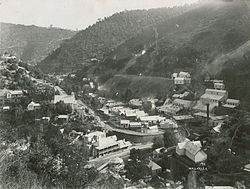
|

|
| Walhalla township in 1910. | Walhalla township in 2004. |
Ghost towns around the world
Africa
Angola
Ilha dos Tigres lies in a zone which is ideally suited for ecological projects. It was mentioned in the 'Unknown Africa-Angola' documentary.
Central African Republic

Actions by government forces and killings by armed gangs created several deserted villages in the Central African Republic from the years 2005 to 2008. Examples are Goroumo, Beogombo Deux, and Paoua.
Cote d'Ivoire
Grand Bassam, Côte d'Ivoire was the French Colonial capital of Côte d'Ivoire until 1896, when it was abandoned by the French Colonial Government. Commercial activity gradually weakened until the city became a virtual ghost town in 1960, the same year Côte d'Ivoire became independent. Today the city has revived somewhat as a tourist center, but it still has the aura of a ghost town.
Democratic Republic of the Congo
At one point, the ghost town of Goma was threatened by a volcanic eruption. Now, Goma is a safe ghost town that the volcano eruption has passed. Still, however, the town lies in ruins. Nastrid was a mining town abandoned in the late 19th century.
Ethiopia
Dallol is a former mining town in Ethiopia. It is located in the Dallol crater, where the temperature can rise as high as 104° Fahrenheit (40 °C).
Mauritania
Though not completely abandoned, Chinguetti could be considered a ghost town.
Namibia
Namibia features a number of ghost towns, most of which had been established after the discovery of diamonds in a 100 km wide strip along the Atlantic coast in southwestern Africa. Shortly after the start of the diamond rush in German South-West Africa, the German imperial government claimed sole mining rights by creating the Sperrgebiet (forbidden zone) in September 1908, effectively criminalizing new settlement. The small mining towns of this area, among them Pomona, Elizabeth Bay and Kolmanskop, were exempt from this ban, but the denial of new claims soon rendered all of them ghost towns.
America
Argentina
Most 19th and 20th century European immigrants to Argentina settled in the cities, which offered jobs, education, and other opportunities that enabled newcomers to enter the middle class. Many also settled in the growing small towns along the expanding railway system. Since the 1930s, many rural workers have moved to the big cities. Other ghost towns were created in the aftermath of dinosaur fossil rushes.
The 1990s saw many rural towns become ghost towns when train services ceased and local products previously manufactured on a small scale were replaced by massive amounts of cheap imported goods. Some ghost towns near cities are tourist attractions.
Brazil
The small village of Caraíbas, in the municipality of Itacarambi, suffered a rare earthquake in the early morning of December 9, 2007. It measured 4.9 on the Richter scale. Located over a geological fault, the village of 76 families was evacuated and has been abandoned ever since.
Fordlândia was established by American industrialist Henry Ford in 1928 near Santarém. This was done to mass-produce natural rubber. Built in inadequate terrain, designed with no knowledge of tropical agriculture, and managed with little regard for local culture, the enterprise was an absolute failure; in 1934, the Ford factory was relocated to Belterra, but ultimately closed down in 1945.
Canada

There are ghost towns in parts of British Columbia, Alberta, Ontario, Saskatchewan, Newfoundland and Labrador (see outport), and Quebec. Some were logging towns or dual mining and logging sites, often developed at the behest of the company. In Alberta and Saskatchewan most ghost towns were once farming communities that have since died off due to the removal of the railway through the town or the bypass of a highway. The ghost towns in British Columbia were predominantly mining towns and prospecting camps as well as canneries and, in one or two cases, large smelter and pulp mill towns. Among the most notable are Anyox, Kitsault, and Ocean Falls. Other notable ghost towns in BC are Cassiar, Bralorne, and Hedley.
British Columbia has more ghost towns than any other jurisdiction on the North American continent, with one estimate at the number of abandoned and semi-abandoned towns and localities upwards of 1500. Some ghost towns have revived their economies and populations due to historical and eco-tourism, such as Barkerville. Barkerville, once the largest town north of Kamloops, is now a year-round Provincial Museum.
Chile
Most of the ghost towns in Chile had once been mining camps or lumber mills, such as the many saltpeter mining camps that prospered from the end of the Saltpeter War until the invention of synthetic saltpeter during World War I. The ghost towns of Humberstone and Santa Laura Saltpeter Works in the middle of the Atacama Desert were declared UNESCO World Heritage Sites in 2005. The copper mining camp of Sewell, Chile, high up in the Andes of Central Chile, was named a UNESCO World Heritage Site in 2006. Despite protection laws, this ghost town suffers "tourist looting."
Port Famine (Template:Lang-es) is arguably Chile's oldest ghost town. It was founded in the Strait of Magellan in 1584 by Pedro Sarmiento de Gamboa. Starvation and the cold climate killed all of the inhabitants. The English navigator Sir Thomas Cavendish landed at the site in 1587. He found only ruins of the settlement, and renamed the place Port Famine.
Chaitén is a small city in southern Chile that was heavily damaged by a volcanic eruption.
Other lesser known ghost towns are located in the southern part of the Chilean Coast Range. They were once lumber mills where Fitzroya were cut down to make roof shingles, a typical element of Chilota architecture.
Colombia
Many ghost towns in this country are the result of ongoing violence by guerrilla groups such as FARC. Bojayá was a small town in the Chocó department. On May 2, 2002, FARC attacked this village, and most of the people hid in the church. FARC threw a bomb into the building, killing approximately 140 people, including 40 children. Today, Bojayá is a ghost town and though plans have been made to rebuild it, it will not be on the exact location of the massacre. However, in the past years violence has been decreasing steadily and people are slowly beginning to go back to their hometowns. Another ghost town is Armero, left in ruins by a volcanic eruption in 1985 that killed over 20,000 inhabitants. Survivors of the tragedy left for other towns and Armero is currently unpopulated.
Guyana
Jonestown in Guyana became a ghost town because of the mass suicide of the Peoples Temple community that lived there.
Mexico
Real de Catorce was once a flourishing silver mining town in northern Mexico. Its dramatic landscapes and buildings have been used by Hollywood for movies such as The Mexican (2001) with Brad Pitt and Julia Roberts. Recent efforts to adapt the town to tourism have created a mixture of ghost town and heritage tourist site adapted to visitors in search of interesting history in the country.
Thompson's Landing was a port at the mouth of the Colorado River. During the early settlement of Arizona, shallow-draft steamboats plied the lower reaches of the river.
Saint Pierre and Miquelon
Sailor's Island (Île aux Marins) is a ghost town/island located a few miles away from the island of Saint-Pierre. Once inhabited by over 600 fishermen, families and tradesmen, the island was progressively abandoned until the last inhabitant left in 1965. The island is now a tourist attraction.
United States
Main article: List of ghost towns in the United States
There are many ghost towns, or semi-ghost towns (some of them unincorporated communities), in the American Great Plains, whose rural areas have lost a third of their population since 1920. Thousands of communities in the northern plains states such as Montana, Nebraska, North Dakota, and South Dakota became railroad ghost towns when a rail line failed to materialize. Hundreds more were abandoned when the US Highway System replaced the railroads as United States favorite mode of travel. Ghost towns are common in mining or old mill town areas: Arizona, California, Colorado, Minnesota, Montana, Nevada, New Mexico, Oregon, and Washington in the western United States and West Virginia in the eastern USA. Some unincorporated towns become ghost towns due to flooding for man made lakes such as Oketeyeconne, Georgia. They can be observed as far south as Arkansas, Florida, Georgia, Louisiana, and Texas. When the resources that had created an employment boom in these towns were consumed, the businesses ceased to exist and the people moved to more productive areas. Sometimes a ghost town consists of many old abandoned buildings (as in Bodie, California); elsewhere, there remain only foundations of former buildings (e.g., Graysonia, Arkansas). Even some of the earliest settlements in the US are or have been ghost towns, such as Jamestown, Virginia, the Zwaanendael Colony in Delaware, and the famous Lost Colony in North Carolina.
Old mining camps that have lost most of their population at some stage of their history, such as Aspen, Colorado; Central City, Colorado; Crested Butte, Colorado; Cripple Creek, Colorado; Deadwood, South Dakota; Marysville, Montana; Oatman, Arizona; Park City, Utah; St. Elmo, Colorado; Tombstone, Arizona; and Virginia City, Montana; are sometimes included in the category, although they are active towns and cities today.
Starting in 2002, an attempt to declare an "Official Ghost Town" in California collapsed when the adherents of the town of Bodie, in Northern California and those of Calico, in Southern California could not come to an agreement as to which of their favorites was more deserving. The ghost town of Medicine Mound in Hardeman County in West Texas is preserved through a museum operated there by Myna Potts. Medicine Mound consists of two buildings; the museum is in the former Hicks-Cobb General Store.
A more recent ghost town is Centralia, Pennsylvania, which, at its peak, had over 2,600 residents in either the borough itself or in immediately adjacent areas. It had over 1,000 as recently as 1981 but as of 2010 has seven residents due to an underground mine fire that started in the 1960s when a landfill created from an abandoned strip mine was set on fire. (At the time, it was legal to create a landfill from an abandoned strip mine if it were isolated from any coal seams that could ignite; this loophole has since been closed because of Centralia.) Pennsylvania later acquired the borough through eminent domain so it could safely move residents to other areas, though a few remain.
Antarctica

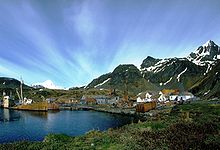
The oldest ghost town in Antarctica is located on Deception Island, where in 1906 a Norwegian-Chilean whaling company started using Whalers Bay as a base for a factory ship, the Gobernador Bories. Other whaling operations followed suit, and by 1914 there were 13 factory ships based there.
Antarctica also has many more-recently abandoned scientific and military bases, especially in the Antarctic Peninsula.
South Georgia and the South Sandwich Islands
The Antarctic island of South Georgia used to have several thriving whaling settlements during the first half of the 20th century, with a combined population exceeding 2,000 in some years. These included Grytviken (operating 1904-64), Leith Harbour (1909–65), Ocean Harbour (1909–20), Husvik (1910–60), Stromness (1912–61) and Prince Olav Harbour (1917–34). The abandoned settlements have become increasingly dilapidated, and remain uninhabited nowadays except for the Museum curator's family at Grytviken. The jetty, the church, and dwelling and industrial buildings at Grytviken have recently been renovated by the Government of South Georgia and the South Sandwich Islands, becoming a popular tourist destination. Some historical buildings in the other settlements are being restored, as well.
Asia
Cyprus
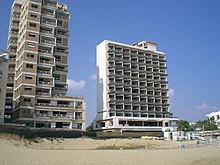
The southern part of Famagusta, also known as Varosha, is fenced off by the Turkish army. Prior to the Turkish Invasion of Cyprus in 1974, it was the modern tourist area of the city of Famagusta. For the last three decades, it has been left as a ghost town.
India
Numerous cities in India have become ghost towns due to various factors. The medieval town of Milakpur Kohi near Sultan Ghari, Delhi is one of the oldest ghost towns in northern India. The medieval Mughal Empire towns of Fatehpur Sikri and Bhangarh in northern India and the medieval Vijayanagara Empire town of Vijaynagara in southern India are some of the most prominent historical ghost towns in India. One of the most recent ghost towns in India is Dhanushkodi, situated on a low-lying island off the Indian coast. Destroyed by tsunami in 1964, Dhanushkodi was declared unfit for living after the killer waves and is a ruin today.
Japan

Hashima Island was a Japanese mining town from 1887 to 1974. Once known for having the world's highest population density (in 1959 at 83,500 people per square kilometer), the island was abandoned when the coal mines were closed down.
There are plans to abandon various remote depopulated villages and towns due to the falling national population.
Malaysia
Kampung Kepayang in Perak state, is almost uninhabited, with only 2 or 3 shophouses being in use. This is a result of the widening of the main road, thus making it difficult to park a vehicle, and result in loss of business of the shops. However, there are still Malays who reside in the village houses behind the shop houses, and the addresses in Simpang Pulai are still written as "Kampung Kepayang."
Oman
Sap Bani Khamis, an abandoned village halfway up a canyon was, is accessible by only a narrow path.
Qatar
Al Arish an old fishing village on the Northern coast of Qatar in the Middle East. Situated on the Persian Gulf, it was abandoned in the early 1970's and has since become a ghost town .
Syria
Most of these towns are in ruins and a few serve as tourist attractions. In addition, the Syrian city of Quneitra has become a ghost town after the 1967 Six Day War and subsequent Yom Kippur war in 1973. As of today, the city remains destroyed. Syria has left the ruins in place and built a museum to memorialize the destruction. It maintains billboards at the ruins of many buildings and effectively preserves it in the condition that the Israeli army left it in.
Turkey
Kayaköy in southwestern Turkey was inhabited by Anatolian Greeks until 1923, when a population exchange was agreed by the Turkish and Greek governments. This left the town as a site of empty houses and Greek churches.
Sazak near Karaburun, a district of İzmir Province on the Aegean (western) coast of Turkey, was also inhabited by Greeks, which left the area according to the population exchange treaty. Nowadays Sazak is a total ghost town.
Çökene in Büyükorhan district was a village until 2008. It is a site of empty houses after immigration to big cities due to money shortage and unemployment.
Europe
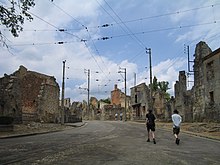

In Europe, many villages were abandoned over the ages for many different reasons.
Sometimes, wars and genocide end a town's life, and it is never resettled. This happened to the Swedish town Sjöstad, Närke in 1260, when the town's 700 merchants crossed the ice of Lake Vättern and were cut down by the Danes. The Danes then proceeded to the town, ravaging and burning it. The town was never resettled. In a farm town named Skyrstad, ruins and a silver treasure which yielded 4000 coins are all that testify to its existence (see abandoned village). The same happened in the French village Oradour-sur-Glane in 1944, when occupying German Waffen-SS troops murdered the village's population.
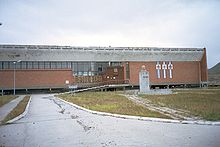
Industrialisation is another factor. For example, the village of Etzweiler in northwestern Germany was abandoned in the 1990s to make way for a coal mine. While Etzweiler disappeared in 2006, neighbouring Pesch and Holz have become near-deserted ghost towns. All that is left of Otzenrath are the remains of the village's church, where archeologists excavate remains of sacred buildings from medieval and potentially Roman times. Furthermore, parts of the motorway A44 have been removed and as the lignitemine continues to move west, parts of the A61 will follow before 2020 (with the A44 being rebuilt behind the mine).
Bulgaria
An increasing number of settlements in Bulgaria are becoming ghost towns as a result of the ongoing demographic decline of the country since the late 20th century. According to the 2001 census, there were 138 uninhabited villages, estimated to have become over 150 by 2006. There are ghost villages in 16 out of the 28 provinces of the country, more numerously in Gabrovo Province (57 in 2001), Veliko Tarnovo Province (34), Kardzhali, Blagoevgrad, Burgas, and Lovech Provinces. Some Bulgarian villages may avoid that fate thanks to immigration of settlers from abroad, mainly from the United Kingdom, but also other EU countries, former Soviet republics, and even Israel and Japan.
Croatia
In Croatia, some Serbian villages in Lika and Banovina regions have been depopulated during the Croatian War of Independence. The village of Grablje on the island Hvar is abandoned.
Czech Republic
There is a ghost town in Milovice, 30 kilometres (19 mi) from the capital, Prague. Milovice consists of four parts, two of which, Milovice-Mladá and Milovice-Boží Dar, were occupied by Soviet soldiers and their families. These two parts were abandoned in 1990-1991 after the Velvet Revolution. The population was about 20,000. Nowadays, Mladá, the central part of Milovice, is being rebuilt and many young people live there. Boží Dar, as well as the nearby airport, is totally abandoned.
Estonia
Former mining towns of Viivikonna and Sirgala started to lose its population after local oil shale reserves were being depleted and the industry moved eastwards. In the 21st century both of the towns had only a handful of people left, struggling to find a new place to live in.
Finland

In Finland, which is one of the most sparsely populated countries in the world, most people live in the biggest towns, and some villages near the Russian border and in Lapland are nearly abandoned. . The mining community on Jussarö island is said to be the only ghost town in Finland.
Germany
Numerous smaller towns and villages in the former eastern territories of Germany were completely destroyed during World War II. These territories became part of Poland and the Soviet Union after the war, and many of the smaller settlements were never rebuilt or repopulated.
Greece
The island of Spinalonga is considered by some to be a ghost town. Serving as a leper colony for the first half of the 20th century, the island was abandoned when all its inhabitants were cured. By 1962 there were no permanent residents left. In recent years Spinalonga has become a tourist attraction, with people visiting one of the last leper colonies to be closed down in Europe.
Hungary

Hundreds of villages were abandoned during the Ottoman wars in the Kingdom of Hungary in the 16-17th century. Many of them were never repopulated but generally they are not classified as ghost towns because few visible traces remained of them. Real ghost towns are rare in present-day Hungary, except the abandoned villages of Derenk (abandoned in 1943) and Nagygéc (abandoned in 1970). Due to the decrease of rural population beginning in the 1980s, dozens of villages are now threatened with abandonment. The first village officially declared as "dead" was Gyűrűfű in the end of the 1970s, but later it was repopulated as an eco-village. Sometimes depopulated villages were successfully saved as small rural resorts like Kán, Tornakápolna, Szanticska, Gorica, and Révfalu.
Ireland

Several communities became ghost towns in Ireland in the latter half of the nineteenth century, particularly in the west of the country, due to a combination of the Great Famine and economic decline brought on by the famine. These now consist primarily of knee-high ruins of cottages. Notable ghost towns are on Achill Island and in the Burren area of county Clare. Montpelier Hill in the Wicklow Mountains was the site of a Hellfire Club, nearby are the ruins of a castle. A more recent ghost town was created in the 1950s on Great Blasket island, where island life became unfeasible and the island was depopulated.
The village of Killary was created for the film Ryan's Daughter on the Dingle Peninsula. The village in the film was built by the production company from stone so that it could withstand the storms. The empty village remained for some time until the buildings were demolished; only the road that went through the town is still visible.
Italy
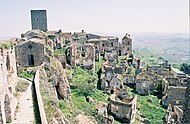
In South Tyrol, there is a ghost city sunken in the Reschensee (a lake). Due to urbanization quite a lot of small villages in the Appennini mountains have been abandoned.
In Basilicata, the ancient site of Craco (in the province of Matera) was depopulated in the middle of the 20th century, due to earthquakes and emigration. The abandonment has made Craco a set of many movies such as The Nativity Story by Catherine Hardwicke, The Passion of the Christ by Mel Gibson and Quantum of Solace by Marc Forster.
Latvia
Skrunda-1, site of a former Hen House radar installation in Latvia, is a ghost town that was auctioned off in its entirety in early 2010.
Poland
A Polish ghost towns: -Kłomino (near to Borne Sulinowo; Russian name - Gródek\Гродек) in the northwest part of the country. It was built for Soviet soldiers and their families. The population was about 5,000. It was completely abandoned in 1992 after the collapse of the USSR. Only a few families live there now, but there are plans to repopulate the city. -Czerwona Woda (Red water) - in the Klodzko Valley - was built, and left by German villagers before IIWW many houses are left by people in Klodzko Valley, especially in mountains
Post-Soviet states
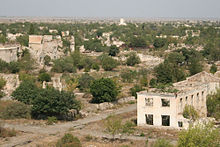
Apart from Pripyat, many abandoned towns and settlements are located in northern Russia (Komi, Taymyr, Chukotka, Iultin). There are several towns that were established near Soviet concentration camps to supply necessary services. Since most of the Gulag installations were abandoned in the 1950s, the towns were abandoned, as well. One such town is located near the former Gulag camp called Butugychag (also called Lower Butugychag). There are several Soviet settlements that were abandoned on the Norwegian island of Svalbard in the town of Grumant. Other towns were deserted due to deindustrialisation and the economic crises of the early 1990 attributed to post-Soviet conflicts.
Agdam, Azerbaijan is an example of this. In July 1993, after heavy fighting, Agdam was captured by the forces of the Nagorno Karabakh Republic during its 1993 summer offensives. As the town fell, its entire population were forced to flee eastwards. Many were killed by Armenian soldiers. In the immediate aftermath of the fighting, the Armenian forces decided to destroy much of Agdam to prevent its recapture by Azerbaijan. More damage occurred in the following decades when the deserted town was looted for building materials. Agdam is currently a ruinous, uninhabited ghost town. The town's large mosque also survives in bad condition.
Even more semi-deserted towns are situated in Georgia's Abkhazia, notably Tkvarcheli and Ochamchire.
In European Russia, many villages have been depopulated since the 1940s.
Scandinavia
Pyramiden (Danish, Swedish and Norwegian, meaning "the pyramid", Russian: Пирамида) was a Russian settlement and coal mining community on the archipelago of Svalbard, Norway. It was founded by Sweden in 1910, and sold to the Soviet Union in 1927. The settlement, with a one time population of 1,000 inhabitants, was abandoned in the late-1990s by its owner, the state-owned Soviet company Trust Artikugol, and is now a ghost town.
Serbia
Many villages in Serbia are now completely abandoned, mostly due to poor living conditions, particularly in eastern and southern parts of the country.
Spain

There are many ghost hamlets in central Spain, as most of their former inhabitants moved to urban areas after the 1960s.
Belchite, in the province of Zaragoza, Aragon, is one of the most well-known ghost towns in Spain. Before the 1930s, Belchite was a growing city, with many services. As a consequence of the Battle of Belchite, during the Spanish Civil War, the city was totally destroyed. Instead of a reconstruction, dictator Franco decided to keep the ruins of the old town of Belchite intact as a memorial of the battle. As of 1964, the town was totally deserted, the inhabitants having been removed to Belchite Nuevo, on the side of the old town. The ruins, which are not accommodated for tourism, are visited by more than 10,000 tourists annually. It is also a well-known meeting point for Francoist nostalgics, especially Falangists.
Ukraine
Since the Chernobyl disaster of 1986, the city of Chernobyl, along with several neighboring cities, have been abandoned.
Prypiat is one of the biggest ghost towns. Pripyat was built to be the home for the workers of the Chernobyl Nuclear Power Plant. At its peak, it had a population of over 50,000 residents; all abandoned the town after the Chernobyl disaster. Unlike the neighboring town Chernobyl, Pripyat remains a ghost town and is completely empty.

Along with Prypiat, the entire Chernobyl Exclusion Zone is full of ghost towns and military installations. After the disaster at Chernobyl NPP, a large area of Ukraine and Belarus was evacuated. This includes quite a few small cities, towns, and villages, as well as a few military installations, such as the Steel Yard Over-the-Horizon radar station. Some of these towns were largely bulldozed and buried due to contamination, but most still have a few remnants, and a few are entirely intact. This area is closed to people, though with the right papers and a guide a person can tour most of this area.
United Kingdom
In the United Kingdom, the once thriving farming village of Knaptoft in Leicestershire was depopulated due to the enclosure of the surrounding land for sheep pasture. The ruins of the former church still exist, as does a graveyard, with graves even occupying ground inside the ruins of the church. The villages of Imber on Salisbury Plain, Wiltshire and Tyneham near Dorset's historic Jurassic Coast, as well as several villages within the Stanford Battle Area in Norfolk, were forcibly abandoned at the injunction of the British Army, and the abandoned buildings are now used for training exercises. The creation of reservoirs has led to the drowning of villages. These include Mardale Green in the English Lake District and two villages - Ashopton and Derwent - drowned by the Ladybower Reservoir in Derbyshire. In Wales, the village of Capel Celyn was drowned to form Llyn Celyn, to provide water for Liverpool, and Llyn Clywedog drowned farmsteads and agricultural land to reduce flooding of the River Severn. The village of Nant Gwrtheyrn on the Llŷn peninsula, North Wales was an old quarry village which was abandoned in the 1950s after the quarry closed because there was no road leading to the village. It has since been restored as a Welsh-language learning centre.
Across the Highlands of Scotland there are several cleared villages from the Highland Clearances of the 19th century, Suisnish and Boreraig on the Isle of Skye being prime examples.
The phrase "D-village" was used to describe mining villages whose population had been re-located when the colliery closed. This name originates from the classification of pit villages as A, B, C or D with D indicating a village to be depopulated and demolished.
Oceania

Australia
Similar to the United States, Canada and other former frontier countries, most ghost towns in Australia were usually formed after the end of mining operations or the removal of railway services. They are spread throughout the country and are located in every state and territory. Some ghost towns in Australia include Cassilis in Victoria, Farina in the far north of South Australia, Newnes and Joadja in New South Wales, Big Bell, Gwalia, Goldsworthy, Cossack, and Wittenoom in Western Australia. Ravenswood in north-eastern Queensland was a ghost town for many years, due to the declining gold rushes, but new gold discoveries in the area and improved mineral processing technologies have boosted the economy of the area and revived the town.
Old Adaminaby in New South Wales is an example of one of the drowned towns which has been subsequently revealed through drought in recent decades.
New Zealand
Most ghost towns in New Zealand are abandoned gold mining townships. Among the more noteworthy is Macetown in Central Otago
Kelso was abandoned after severe and repeated flooding in the late 1970s and early 1980s.
See also
- Abandoned mine
- Abandoned village
- Deserted medieval village
- List of ghost towns
- Old field (ecology)
- Rotten borough
- Unused highway
- Urban decay
- Urban Exploration
Notes
- More Ghost Towns of Texas. Norman, OK: University of Oklahoma Press. 2003.
- "The Economics of Ghost Towns by Philip Graves, Stephan Weiler, Emily Tynon :: SSRN". Papers.ssrn.com. 25 January 2010. Retrieved 28 December 2011.
- Brundage, John F.; Shanks, G. Dennis (2008). "Deaths from Bacterial Pneumonia during 1918–19 Influenza Pandemic". Emerging Infectious Diseases(web serial). 14 (8). U.S. Centers for Disease Control. Retrieved 11 July 2010.
{{cite journal}}: Unknown parameter|month=ignored (help) - Annual report of the Surgeon General of the Public Health Service of the United States - 1920. Washington, DC: Public Health Service. 1920.
- 1918 Flu Epidemic nwaonline.net; Northwest Arkansas Online.
- Unknown Africa-Ilha dos Tigres
- "Massacre haunts CAR villagers". BBC. 18 December 2008. Retrieved 18 December 2008.
- "Deserted villages and abandoned lives". BBC. 15 December 2008. Retrieved 18 December 2008.
- Goma
- Santcross, Nick. Namibia Handbook: The Travel Guide. Footprint Books. ISBN 1-900949-91-1. Retrieved 24 May 2008.
{{cite book}}: Unknown parameter|coauthors=ignored (|author=suggested) (help) - Bruce Ramsey, Ghost Towns of British Columbia", Mitchell Press, Vancouver (1963-1975)
- NSTATE, LLC: http://www.n-state.com. "California State Gold Rush Town, Bodie, from". Netstate.Com. Retrieved 28 December 2011.
{{cite web}}: External link in|author= - See Bill O'Neal, Ghost Towns of the American West (1995).
- "Oman article 2". Worldwisewanderer.com. Retrieved 28 December 2011.
- Qatar's abandoned fishing villages Qatar Japan 2012
- Geçim sıkıntısı 'hayalet köy' yarattı CNNTurk.com. Retrieved 2010-03-11.
- "Etzweiler - Modern ghost town in Germany". Xs4all.nl. 2 February 2002. Retrieved 25 August 2009.
- "Diggelfjoer: Abandoned". Diggelfjoer.swalker.nl. 27 September 2002. Retrieved 25 August 2009.
- "Urban exploration: Otzenrath ghost town". Forbidden-places.net. Retrieved 25 August 2009.
- Monitor Daily, Dr. Boris Kolev: Over 150 are the dead villages in Bulgaria, Sofia, August 8, 2006 (in Bulgarian)
- Trud Daily, Foreigners colonize native villages, Sofia, August 13, 2007 (in Bulgarian)
- page 71, Geografija 2 - udžbenik za drugi razred gimnazije, Dužanec, R., Nebeski Hostić, S., Polan, Ž., Meridijani, Zagreb 2007.
- Reporter.ee
- www.imdb.com. "Filming locations for Nativity". Retrieved 24 May 2011.
- www.imdb.com. "Filming locations for The Passion of the Christ". Retrieved 24 May 2011.
- www.imdb.com. "Filming locations for Quantum of Solace". Retrieved 24 May 2011.
- Nicolas Holding, "Armenia with Nagorno Karabagh - Bradt Travel Guide", 2003, p200.
- Города-призраки. Агдам – жертва мести, памятник глупости. Template:Ru icon
- Отчет о велосипедном походе по Армении и Нагорному Карабаху 2007
- "The agricultural sector in Ochamchira, Tkvarcheli and Gali, Abkhazia, Georgia" (PDF). Retrieved 25 August 2009.
- "Russia: more evidence found of rural depopulation trend.(Brief Article) | IPR Strategic Business Information Database | Find Articles at BNET". Findarticles.com. 2 June 2009. Retrieved 25 August 2009.
- "The Highland Clearances". Walkhighlands.co.uk. Retrieved 28 December 2011.
- "Category-D villages in County Durham - Waggonways". Sites.google.com. Retrieved 28 December 2011.
- "Drought uncovers Australia's drowned town". News.brisbanetimes.com.au. 19 April 2007. Retrieved 25 August 2009.
References
- Ghost Towns of Texas by T. Lindsey Baker, University of Oklahoma Press, 1991, Paperback, ISBN 0-8061-2189-0
- Standing legacy: Ghost towns preserve the Ottawa Valley’s rich history. Photography by Paul Politis and text by Tobi McIntyre. (Source: Canadian Geographic
- Stampede to Timberline, Colorado's Ghost Towns and Mining Camps by Muriel Sibell Wolle, Revised and Enlarged Edition, Paperback, Swallow Press, 1991, ISBN 0-8040-0946-5
- Timberline Tailings, Tales of Colorado's Ghost Towns and Mining Camps, Muriel Sibell Wolle, Sage Books, Swallow Press, 1993, Paperback, ISBN 0-8040-0946-5; older hardback editions are available as used books.
- Ghost Towns of the American West by Berthold Steinhilber (Photographer), Mario Kaiser (Author), Michael Koetzle (Author), Wim Wenders (Author), Harry N. Abrams, 2003.
External links
- Ghost Town Gallery (With about 200 Ghost Towns throughout the American west)
- Lost Places in the world and Lost Italy (english and italian language)
- Ontario Abandoned Places (Ghost Towns in Canada)
- Ten classic ghost towns worldwide
- GhostTowner.com - The How-To for visiting Ghost Towns
- Coloradopast.com - Ghost Towns and Historic locations in Colorado
- Ghost Town Italy (Italian Language)
- Ghost Towns of Arizona and Surrounding States
Individual places
- Ötzenrath, Germany
- Abandoned towns, villages and other communities in Great Britain
- Map showing the towns buried under Quabbin as they looked in 1912 with original house locations and current reservoir water level
- Dead Lonesome, Part 1 of 2 (Youtube video)
- Dead Lonesome, Part 2 of 2 (Youtube video)
- Are we building Ghost Towns?, Indian Real Estate for Dummies
- Ghost Towns,Now you see um, now you don't, By Dr. Q. Braiwick
Chernobyl disaster-related
- Photographic Journey (Note: some statements described as fact on this site are disputed)
Categories: